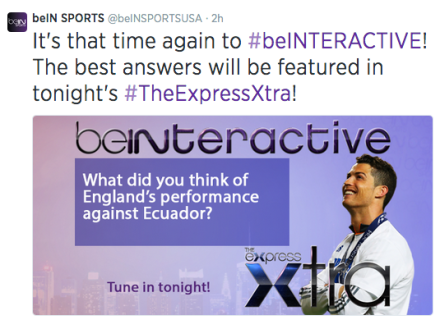Background
Approximately 63% of the American public watch sports, according to a USA Today Gallop Poll. Those numbers are staggering when you think about it. People love the sporting industry, simple as that. How many times do you see sports team being promoted on people’s clothing, cars, houses, etc.? When you go to restaurants, stores and people’s houses—how often do you see sports on TV? I for one can say that I can’t remember a day to which I didn’t tune into a sporting event. They are what drives many people, brings excitement and passion into their lives. It’s not just coincidental that the most recent Super Bowl, Super Bowl XLVII, was the most watched television program in the history of the United States.
Due to the rise in the popularity of sports, we are also seeing a rise in sports networks, broadcasts, reporters, writers, websites and blogging. There is money to be made in sports, but only if you can find a way to appeal to the fans. Just as sports rely on fans, so do sport’s programs. Without fans, the industry is obsolete. So the question is, what type of “production” could bring in these fans?
Personally, I feel we are lacking an overall sports program that appeals to the hardcore fan. Believe it or not, there are people out there who really live and die by their team. It’s a part of their life, a passion, something to look forward to every time their team plays. These fans have a passion, and many times, go great lengths to let their passion be shown.

I’ve said it once and I’ll say it again. In order to find space in this competitive marketplace, you have to find a way to reach the fans by giving them something original, unique and entertaining. There is no competing with the big business of the major sports networks like ESPN, CBS, and FOX. They have established themselves in the upper echelon of sports, and they have gained trust in the public with their diligent reporting and amazing broadcasts. The best option to enter into the big sports outlets is to have one of these networks actually pick up your program—easier said than done.
Focus
What I’m looking to create is an online sports program that brings a new style of analyzing and reporting sports. I’m going to establish a more “personable” sports broadcast, with few limits. The overall concept is to let people discuss sports as they would with their friends, family and fellow fans. The overall uses of profanity, aggression and smack talking are more than welcomed. It is a program that is uncensored, it let’s people say what’s on their mind and debate with other fans on the topic.
Sure, it could be looked at as distasteful and questionable when you provide people an open and uncensored forum, but there is a market for that. Social  media has become a dominant outlet in people discussing and engaging with fellow fans on various sporting events and programs. The program will look to hit on trending topics and issues, while motivating people to become involved. There needs to be a sports program that is uncensored, real, and at times, inappropriate.
media has become a dominant outlet in people discussing and engaging with fellow fans on various sporting events and programs. The program will look to hit on trending topics and issues, while motivating people to become involved. There needs to be a sports program that is uncensored, real, and at times, inappropriate.
The program that I’m looking to establish is called “The Sports Riport.” Along with my friend who has background in web design, VFX, graphics, filming and editing—we are looking to get the ball rolling as soon as possible. The name was chosen to show that we are promoting the “edgy” side of sports. That we aren’t “reporting,” we’re “riporting.” In translation, we are “ripping” or being “controversial” on many sporting issues, and encourages our audience to do the same.
Target Audience
I feel out most beneficial key public would be sports fans in general. Predominately, the one’s who are “actively” involved in the industry that can relate to more of an “advanced” style of sporting conversations. Once a descent fan base can be established for the program, we can then look for them to promote our brand. The way I’m looking into going about it is through social media engagement. We need our audience to know that we want to hear people’s thoughts and opinions, while offering a response, ultimately creating a productive conversation. Our demographics would range in more of the “adult” range, considering there will be limited censorship.
Promotion
Effectively promoting a brand, especially a start-up, is invaluable. Without successfully getting our brand image and message out, we are putting ourselves in a nearly impossible situation of trying to attract an audience. Considering we are in the beginning stages, we are looking to hit social media hard. The best way to do this is to stay on top of trending sports topics, engage audience’s topics, send personal tweets and encourage them to support our brand. We have to build that initial audience in order to progress.

Once the brand attains recognition, whether that’s on a small or large scale, we will then look to begin on “incentive type promotion.”
Such as:
“Tweet us your sports topic, and we will debate it.”
This will get people involved, hopefully we can answer some of their questions.
“Who will win the NCAA Basketball Tournament? Winner receives $25 gift card.”
We would chose a random person out of all the people who got predicted the champion, then directly message them if they win, as well as post the winner on our social media channels so other’s will know it’s a legitimate promotion.
“Click here (a bit.ly) link to visit our website The Sports Ripport”
Utilizing bit.ly will be important so we can monitor where we are receiving the most success based on each platform. Also will add a link to our “shop” page and offer various discounts with promo codes.
Utilizing Proven Promotions/Campaigns
Taking advice of some proven social media promotions, the New Jersey Devil’s NHL Hockey team created a “Mission Control” on social media to bring fans closer to the team. The best part is the fans basically worked for the team. As volunteers, they would monitor social media channels and answer questions. What this allowed for was more engagement with their audience. A big issue with engaging followers on social media is actually being able to individually respond to each message sent to you. What the Devils did was bring in people to answer questions; they acted as a “support team” for the organization.

The Devils actually profited from the campaign, almost doubled their Facebook fans and had their Twitter account reach over 25,000 followers. I feel the success came because instead of looking at a viewer as “part of the crowd,” they individually catered to them, thus increasing the overall “personal” feel. You want to get your audience and customers involved in your social media campaign, and if you can make them brand advocates, it can be successful. I feel the NJ Devils stand as a symbol of one of the most effective sports social media campaigns to date.
Implementing a Similar Promotion
In order to create a similar promotion to “Mission Control,” we need fan involvement. We can do this by providing rewards to people who participate. By monitoring a certain social media platform, those who are the most engaging as  far as being advocates, will receive the most attention. We will take a handful of people and put them into a drawing, and the winner would receive a prize. These prizes won’t be anything extravagant, a gift card, or half off at the store—something of that nature.
far as being advocates, will receive the most attention. We will take a handful of people and put them into a drawing, and the winner would receive a prize. These prizes won’t be anything extravagant, a gift card, or half off at the store—something of that nature.
Due to the continual increasing of popularity in online incentives, we can’t afford to skip on it. As a start-up brand, there has to be a “reason” for people to chose us. If we can reach an audience of sports followers, let them know what we do and that we run various promotions for our followers—then we have a chance to compete in the marketplace.
Monitoring
Keeping a firm grasp on our analytics will be crucial for this brand. With using real-time analytics, we will be able to monitor visitor activity as it happens; therefor we limit the risk of falling behind with our audience. This will be effective when people visit our website, so we can see exactly the experience they had. As much of our program is involved with social media, we still need to attract visitors to our website. The website stands as the centerpiece of this brand. Social media acts as our outlets to bring in engagement and conversation, but ultimately getting them involved in our website is our main goal.
Analytics
Collecting data is a key part of any online campaign. We want to ensure we continue to monitor each of our online platforms. When people take the time to offer conversation to us about our brand, it is our responsibility to return an answer.
Adding social plug-ins will also assist in our effort of advertising. The audience needs to easily be able to connect to all of our digital spots.
Social media marketing will also be essential. Social listening will allow us to learn about what conversations are happening and where. We need this information, simply because we have to fin da way for people to notice our brand.
Google Analytics will also be necessary. We are firm believers in trying to stand out the best we can on anything Google related. Every blog post will be connected to our Gmail account to increase our SEO. Google’s “Activity Stream” will be utilized. It will assist us in monitoring online conversations, one of our primary focuses.

Final Goal
Although currently in the beginning stages, I feel bringing a more personal and uncensored side to sports could yield a big audience. Fans are passionate people and they enjoy the aggressive and competitive side of sports. They aren’t always polite, reasonable or respectful to other fans or teams—but it’s all part of the game.
Attracting the appropriate audience, supported by 2 sports enthusiasts who create original, entertaining and controversial sports content can find a place in this industry.

 A recent issue came about when United Airlines baggage handlers broke a customers guitar. The “victim” took an aggressive approach and attacked the brand on all accounts, even producing a viral song and video about his dissatisfaction with the handling of his guitar. United Airlines initially did nothing for the man, and didn’t show much consideration to his unfortunate circumstance. Considering this man was gaining support for his claim, United should have seen that and addressed the situation to prevent it from spreading. Since they did no such thing, they are a prime example of what can happen when negative publicity hits the masses.
A recent issue came about when United Airlines baggage handlers broke a customers guitar. The “victim” took an aggressive approach and attacked the brand on all accounts, even producing a viral song and video about his dissatisfaction with the handling of his guitar. United Airlines initially did nothing for the man, and didn’t show much consideration to his unfortunate circumstance. Considering this man was gaining support for his claim, United should have seen that and addressed the situation to prevent it from spreading. Since they did no such thing, they are a prime example of what can happen when negative publicity hits the masses.




























